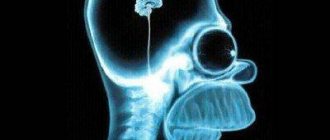Symptoms of a mental disorder
The World Health Organization divides the symptoms of mental disorders in humans into 4 main groups:
- Sensory-perceptual symptoms in which a person has a distortion of reality and can hear, feel or see things that others cannot sense.
- A common neurological symptom is cognitive impairment. The patient is increasingly experiencing a disorder of clear speech, memory lapses occur, and pathological beliefs about an event are established.
- Symptoms of a behavioral nature, when the patient may show unreasonable aggression towards relatives or stop performing daily functions.
- Emotional disorders most often occur as the main symptom; the patient may constantly feel a feeling of fear or sadness.
How to persuade people to take medications and hospitalization?
– How to communicate with a person who has an exacerbation of an already known psychiatric disease?
– Everything is individual.
The main rule is that in these situations, accusations against the sufferer are categorically inappropriate: “... it’s your own fault, you’ve let yourself go, you rag, pull yourself together...”
We will not blame a person who fell ill with diphtheria for the fact that he had an unfortunate trip on the bus, where he was coughed on. The fear of harming the patient with a careless word or an inappropriate grin, skepticism, irony, or when we begin to feel guilty for his condition is already a neurotic symptom. Remember, even if after a psychotherapeutic conversation with a patient something bad happened to him, this is the work of his illness, and not your miscalculation.
Unless there is a deep morbid predisposition, it is impossible to harm a mentally ill person with a careless word so much that he would take any drastic actions. This is due to the manifestations of the disease, which would have appeared anyway.
– How to insist that a person takes medications?
– If a person with a mental illness refuses to take medication, you need to figure out why he is doing this. Perhaps, by doing so, he wants to prove to his relative, who insists on treatment, that he can cope with the disease himself.
As we dig further, we may well discover that there is some old conflict behind this, and so on. Everything has a reason. If this is due to a conflict with relatives, then these relatives should consult a psychologist or psychotherapist themselves in order to understand for themselves the problems associated with this conflict. Then try to resolve the conflict, and after that the persuasion to see a doctor will become more effective.
I can answer: yes, you need to persuade, pat on the head, put pressure, insist, blackmail - use any means, as long as the person gets treatment. But this will look formal and often unpromising.
The human soul is a complex and subtle instrument.
And the most important key to influencing her is not “methods,” but openness, honesty, and sincerity. When you achieve it, everything happens, including setting the person up for treatment. Where to go about mental illness? In Russia there are several options. Each region has its own specifics. Information on Moscow: Moscow service of psychological assistance to the population. These are government centers in each district, where most of the specialists are clinical psychologists, but there are also psychotherapists. There is also a suicide service and a helpline there. Advantages . A free public service that you can contact anonymously and 24 hours a day (helpline). Flaws. A significant shift away from psychiatry towards psychology.
Most mental disorders require years of follow-up with the same physician. In the conditions of a psychological service, such work with a patient is impossible. – And if there is no time to talk, is the person already in the “acute phase”?
– If a person is in an exacerbation, there is Article 29 of the “Law on Psychiatry”, which provides for the possibility of involuntary hospitalization of a sick person if, due to his mental state, he is dangerous to himself or others, is helpless, or the lack of treatment can seriously worsen his health.
Signs of a mental disorder
Every second person with a mental disorder, starting from the early stages of the disease, experiences characteristic symptoms. They can appear with different intensities and frequency, but they are easy to notice with constant observation of a person. If one of the signs appears, you cannot leave it unnoticed and you should seek professional help.
Signs of a mental disorder most often go beyond certain cultural norms or beliefs in modern society. It is customary to identify the main signs of the course of the disease, which are most common among people with this diagnosis - memory impairment and sound thinking, sudden changes in a person’s behavior and mood for no known reason.
People who can adapt to living conditions and solve life problems are usually assessed as mentally healthy. If these abilities are limited and a person cannot cope with everyday tasks in personal, family life or at work, when he is unable to achieve personal goals, then we may be talking about one or another degree of mental disorder. Today, such pathologies are much more common than is commonly believed. According to WHO, every fourth to fifth person in the world has a mental or behavioral disorder. Symptoms of mental illness are always very variable and varied, but they are all associated with a disorder of higher nervous activity. Mental disorders affect a person’s behavior and thinking, his perception of the surrounding reality, memory and other important mental functions. Clinical manifestations of mental diseases in most cases form entire symptom complexes and syndromes. Thus, a sick person may experience very complex combinations of disorders, which only an experienced psychiatrist can evaluate to make an accurate diagnosis. Let's consider the main symptoms and syndromes of mental disorders in order of their severity - from mild to more profound, when they appear, experts recommend seeking professional help
Asthenic syndrome.
Asthenic syndrome (asthenia) is a widespread condition that is manifested by increased fatigue, exhaustion, and decreased performance. People with asthenic disorders experience weakness, instability of mood, they are characterized by impressionability, sentimentality, and tearfulness; They are easily moved, they are easily irritated, they lose their composure over any little thing. Asthenic conditions are also characterized by frequent headaches and sleep disturbances (it becomes superficial, does not bring rest, and increased sleepiness is noted during the day). Asthenia is a nonspecific disorder, i.e. can be observed in almost any mental illness, as well as in somatic diseases, in particular after operations, severe infectious diseases, or overwork.
Obsessiveness.
Obsessions are experiences in which a person, against his will, has any special thoughts, fears, doubts. At the same time, a person recognizes them as his own, they visit him again and again, it is impossible to get rid of them, despite a critical attitude towards them. Obsessive disorders can manifest themselves in the emergence of painful doubts, completely unjustified, and sometimes simply ridiculous thoughts, in an irresistible desire to count everything. A person with such disorders may check several times whether he has turned off the light in the apartment, whether he has closed the front door, and as soon as he moves away from the house, doubts take possession of him again.
This same group of disorders includes obsessive fears - fear of heights, enclosed spaces, open spaces, traveling in public transport and many others. Sometimes, in order to relieve anxiety, internal tension, and calm down a little, people experiencing obsessive fears and doubts perform certain obsessive actions or movements (rituals). For example, a person with an obsessive fear of pollution may spend hours in the bathroom, repeatedly wash his hands with soap, and if he is distracted by something, start the whole procedure again and again.
Affective syndromes.
These mental disorders are the most common. Affective syndromes are manifested by persistent changes in mood, most often a decrease in mood—depression, or an increase in mood—mania. Affective syndromes often occur at the very beginning of mental illness. They may remain predominant throughout, but may become more complex and coexist for a long time with other, more severe mental disorders. As the disease progresses, depression and mania are often the last to disappear.
When we talk about depression, we primarily mean its following manifestations.
- Decreased mood, feeling of depression, depression, melancholy, in severe cases physically felt as heaviness or chest pain. This is an extremely painful condition for a person.
- Decreased mental activity (thoughts become poorer, shorter, more vague). A person in this state does not answer questions immediately - after a pause, gives short, monosyllabic answers, speaks slowly, in a quiet voice. Quite often, patients with depression note that they find it difficult to understand the meaning of the question asked of them, the essence of what they read, and complain of memory loss. Such patients have difficulty making decisions and cannot switch to new activities.
- Motor inhibition - patients experience weakness, lethargy, muscle relaxation, talk about fatigue, their movements are slow and constrained.
In addition to the above, characteristic manifestations of depression are:
- feelings of guilt, ideas of self-blame, sinfulness;
- a feeling of despair, hopelessness, impasse, which is very often accompanied by thoughts of death and suicide attempts;
- daily fluctuations in condition, often with some relief of well-being in the evening;
- sleep disorders; shallow, intermittent night sleep, with early awakenings, disturbing dreams, sleep does not bring rest).
Depression may also be accompanied by sweating, tachycardia, fluctuations in blood pressure, feelings of heat, cold, chilliness, loss of appetite, weight loss, constipation (sometimes symptoms such as heartburn, nausea, and belching occur in the digestive system). Depression is characterized by a high risk of suicide! Read the text below carefully - this will help you to notice in time the appearance of suicidal thoughts and intentions in a person with depression
If you have depression, the possibility of a suicide attempt is indicated by:
- statements of a sick person about his uselessness, guilt, sin;
- a feeling of hopelessness, meaninglessness of life, reluctance to make plans for the future;
- sudden calm after a long period of anxiety and melancholy;
- accumulation of medications;
- a sudden desire to meet old friends, ask forgiveness from loved ones, put your affairs in order, make a will.
The appearance of suicidal thoughts and intentions is an indication to immediately consult a doctor and decide on hospitalization in a psychiatric hospital!
Manias (manic states) are characterized by the following symptoms.
- Increased mood (fun, carefree, rosy, unshakable optimism).
- Acceleration of the pace of mental activity (the appearance of many thoughts, various plans and desires, ideas of overestimation of one’s own personality).
- Motor excitement (excessive liveliness, mobility, talkativeness, feeling of excess energy, desire for activity).
Manic states, like depression, are characterized by sleep disturbances: usually people with these disorders sleep little, but a short sleep is enough for them to feel alert and rested. With a mild version of the manic state (so-called hypomania), a person experiences an increase in creative powers, an increase in intellectual productivity, vitality, and performance. He can work a lot and sleep little. He perceives all events with optimism. If hypomia turns into mania, that is, the condition becomes more severe, the listed manifestations are accompanied by increased distractibility, extreme instability of attention and, as a result, loss of productivity. Often people in a state of mania look lightweight, braggarts, their speech is replete with jokes, witticisms, quotes, their facial expressions are animated, their faces are flushed. When talking, they often change their position, cannot sit still, and actively gesticulate. Characteristic symptoms of mania are increased appetite and increased sexuality. The behavior of patients can be unrestrained, they can establish multiple sexual relationships, and commit thoughtless and sometimes ridiculous actions. A cheerful and joyful mood can be replaced by irritability and anger. As a rule, with mania, the understanding of the painfulness of one’s condition is lost.
Senestopathies.
Senestopathies (Latin sensus - feeling, sensation, pathos - illness, suffering) are symptoms of mental disorders, manifested by extremely diverse unusual sensations in the body in the form of tingling, burning, twisting, tightening, transfusion, etc., not associated with any disease internal organ. Senestopathies are always unique, unlike anything else. The vague nature of these disorders causes serious difficulties when trying to characterize them. To describe such sensations, patients sometimes use their own definitions (“rustling under the ribs,” “squelching in the spleen,” “it seems like the head is coming off”). Senestopathy is often accompanied by thoughts about the presence of some kind of somatic disease, and then we are talking about hypochondriacal syndrome.
Hypochondriacal syndrome.
This syndrome is characterized by persistent preoccupation with one's own health, constant thoughts about the presence of a serious, progressive and possibly incurable somatic disease. People with this disorder present persistent physical complaints, often interpreting normal or routine sensations as manifestations of illness. Despite the negative results of the examinations and the dissuading specialists, they regularly visit different doctors, insisting on additional serious examinations and repeated consultations. Hypochondriacal disorders often develop against the background of depression.
Illusions.
When illusions arise, real-life objects are perceived by a person in a changed—erroneous—form. Illusory perception can also occur against the background of complete mental health, when it is a manifestation of one of the laws of physics: if, for example, you look at an object under water, it will seem much larger than in reality. Illusions can also appear under the influence of a strong feeling - anxiety, fear. So, at night in the forest, trees can be perceived as some kind of monster. In pathological conditions, real images and objects can be perceived in a bizarre and fantastic form: a wallpaper pattern as a “tangle of worms,” a shadow from a floor lamp as a “head of a scary lizard,” a pattern on a carpet as a “beautiful unprecedented landscape.”
Hallucinations.
This is the name for disorders in which a person with a disturbed psyche sees, hears, feels something that does not exist in reality.
Hallucinations are divided into auditory, visual, olfactory, gustatory, tactile, and general sense hallucinations (visceral, muscular). However, their combination is also possible (for example, a sick person can see a group of strangers in his room and hear them talking).
Auditory hallucinations manifest themselves in the patient’s pathological perception of certain words, speeches, conversations (verbal hallucinations), as well as individual sounds or noises. Verbal hallucinations can be very different in content - from so-called calls, when a sick person hears a voice calling him by name or surname, to entire phrases and conversations involving one or more voices. Patients call verbal hallucinations “voices.”
Sometimes the “voices” are of an imperative nature - these are the so-called imperative hallucinations, when a person hears an order to remain silent, to hit, to kill someone, or to harm himself. Such conditions are very dangerous both for the patients themselves and for those around them, and therefore are an indication for serious drug treatment, as well as special monitoring and care.
Visual hallucinations can be elementary (in the form of sparks, smoke) or objective. Sometimes the patient sees entire scenes (battlefield, hell). Olfactory hallucinations most often represent an imaginary sensation of unpleasant odors (rotting, decay, poisons, some kind of food), less often unfamiliar or pleasant ones.
Tactile hallucinations occur mainly in later life, with patients experiencing burning, itching, stinging, pain, other sensations, and touching the body. The text below lists the signs by which one can determine or at least suspect the presence of auditory and visual hallucinatory disorders in a sick person.
Signs of auditory and visual hallucinations.
- conversations with oneself that resemble a conversation (for example, emotional answers to some questions);
- unexpected laughter for no reason;
- anxious and preoccupied look;
- difficulty concentrating on a topic of conversation or a specific task;
- a person listens to something or sees something that you cannot see.
Delusional disorders.
According to experts, such disorders are among the main signs of psychosis. Defining what delirium is is not an easy task. With these disorders, even psychiatrists often disagree in their assessment of the patient’s condition.
The following signs of delirium are distinguished:
- It is based on incorrect conclusions, erroneous judgments, and false beliefs.
- Delirium always arises on a painful basis - it is always a symptom of a disease.
- Delusion cannot be corrected or dissuaded from the outside, despite the obvious contradiction with reality, a person with delusional disorder is completely convinced of the reliability of his erroneous ideas.
- Delusional beliefs are of extreme significance for the patient; one way or another, they determine his actions and behavior.
Delusional ideas are extremely diverse in their content. These ideas could be:
- persecution, poisoning, influence, material damage, witchcraft, damage, accusations, jealousy;
- self-deprecation, self-blame, hypochondriacal, denial;
- invention, high birth, wealth, greatness;
- love, erotic delirium.
Delusional disorders are also ambiguous in their form. There is a so-called interpretive delusion, in which the evidence of the main delusional idea is one-sided interpretation of everyday events and facts. This is a fairly persistent disorder when a sick person is disrupted in reflecting cause-and-effect relationships between phenomena. Such nonsense is always logically justified in its own way. A person suffering from this form of delusion can endlessly prove that he is right, give a lot of arguments, and debate.
Another form of delirium is sensory or figurative delirium, which occurs against a background of anxiety, fear, confusion, severe mood disorders, hallucinations, and disturbances of consciousness. Such delirium is observed in acutely developed painful conditions. In this case, during the formation of delusions, there is no evidence or logical premises, and everything around is perceived in a special “delusional” way. Often the development of acute sensory delirium syndrome is preceded by such phenomena as derealization and depersonalization. Derealization is a feeling of change in the world around us, when everything around is perceived as “unreal”, “rigged”, “artificial”; depersonalization is a feeling of change in one’s own personality. Patients with depersonalization characterize themselves as having “lost their own face,” “becoming stupid,” and “losing the fullness of their feelings.”
Catatonic syndromes.
This is how conditions are defined in which disturbances in the motor sphere predominate: retardation, stupor (Latin stupor - numbness, immobility) or, on the contrary, excitement. With catatonic stupor, muscle tone is often increased. This condition is characterized by complete immobility, as well as complete silence and refusal to speak. A person can freeze in the most unusual, uncomfortable position - with his arm extended, one leg raised, with his head raised above the pillow.
The state of catatonic excitation is characterized by chaoticity, lack of purpose, and repetition of individual movements, which can be accompanied by either complete silence or shouting of individual phrases or words. Catatonic syndromes can be observed even with clear consciousness, which indicates a great severity of disorders, and be accompanied by confusion. In the latter case, we are talking about a more favorable course of the disease.
Syndromes of confusion.
These conditions occur not only in mental disorders, but also in severe somatic patients. When consciousness is clouded, perception of the environment becomes difficult, contact with the outside world is disrupted. There are several syndromes of stupefaction. They are characterized by a number of common features.
- Detachment from the outside world. Patients are unable to comprehend what is happening, as a result of which their contact with others is disrupted.
- Disorientation in time, place, situation and in one’s own personality.
- Thinking disorder is a loss of the ability to think correctly and logically. Sometimes there is incoherent thinking.
- Memory impairment. During the period of clouding of consciousness, the assimilation of new information and the reproduction of existing information are disrupted. After emerging from a state of impaired consciousness, the patient may experience partial or complete amnesia (forgetting) of the transferred state.
Each of the listed symptoms can occur in different mental disorders, and only their combination allows us to talk about clouding of consciousness. These symptoms are reversible. When consciousness is restored, they disappear.
Dementia (dementia).
Dementia is a deep impoverishment of all mental activity of a person, a persistent decrease in all intellectual functions. With dementia, the ability to acquire new knowledge and their practical use deteriorates (and sometimes is completely lost), and adaptability to the outside world is impaired. Experts distinguish between acquired pathology of intelligence (dementia, or dementia), which develops as a result of the progression of certain mental illnesses, and congenital pathology (oligophrenia, or dementia).
To summarize the above, we note that this lecture provides information about the most common symptoms and syndromes of mental disorders. Mental disorders can develop in men and women at any age, regardless of their race or ethnicity. Conventionally, external and internal causative factors that can lead to mental disorders are distinguished. Internal ones include: genetic mutations, metabolic disorders, endocrine pathology. External ones are infections, intoxications, head injuries, brain hypoxia and others. An important role is played by the factor of strong emotional stress, which in a person with weak mental defense mechanisms can be a trigger for the onset of a mental disorder. It is important to note that the symptoms of mental disorders may be transient in nature and subsequently, throughout life, never recur. In most cases of mental disorders, diagnosis and effective treatment are possible.
If you or someone close to you experiences one or more of the symptoms listed above, we strongly recommend that you seek professional help from a psychiatrist. It is worth noting that the earlier the diagnosis is made, the more effective the treatment of the psychopathological disorder will be.
Causes of mental disorders
Scientists have found that the reasons for changes in a person’s mental state can be external factors such as psychological or social. Biological factors include a genetic predisposition to constant depression or nervous breakdowns, especially if, while a person was growing up, there were complex relationships between parents that left a certain imprint on the child’s psyche.
The results of many years of research have shown that the causes of mental disorders most often come from the patient’s unfavorable childhood. Drugs and alcoholism, temporary restriction of a person’s freedom in a confined space, frequent depression, difficult life situations and incidents can also lead to the development of the disease.
Types of mental disorders
Currently, the most common diseases include some types of human mental disorders. These data can always be tracked in the reports of the World Health Organization, where schizophrenia is among the top five most common diseases among the entire world population. It can originate during early human development, but in the transition period its signs will begin to increase.
In second place in popularity are types of disorders associated with the abolition of dependence on psychotropic or narcotic substances, including alcohol. Depression, as a type of mental disorder, occurs in every fifth inhabitant of the planet and is accompanied by pessimistic views of life and an apathetic mood.
Psychotrauma
How exactly a woman reacts to traumatic situations is determined by her character, life principles, social and financial status. Thus, some people perceive, for example, a loss of job or a delay in salary quite easily; for others, such unpleasant events can cause prolonged depression.
But the most common etiological factors of psychotic disorders are:
- emotional and/or physical abuse;
- serious illness, death of loved ones;
- global disasters, pandemics, crises;
- accidents;
- diagnosed pathology (we are talking about incurable or difficult to treat diseases), etc.
Psychological mental disorders
According to the International Classification of Diseases, psychological mental disorders belong to groups F10 – F19 and are associated with human behavior disorder due to excessive use of psychoactive substances.
Most often, this type of disorder occurs against the background of addiction to a certain type of psychotropic drug. A person is convinced on a subconscious level that it is psychotropic substances that give him a dose of pleasure and without them he cannot exist normally. Over time, addiction occurs, which cannot be eliminated without professional help and treatment.
Cotard's syndrome
One of the striking characteristics of this syndrome is delusions of grandeur turned inside out: a person believes that he or certain parts and organs of his body have already died, rotted, decomposed, or are simply missing.
Still from the film "Pirates of the Caribbean: Dead Men Tell No Tales"
A person with Cotard's syndrome is often convinced that he is causing catastrophic harm to humanity: that he has infected everyone with a terrible infection, poisoned or completely wiped out humanity from the face of the earth, that because of his putrefactive breath the planet will soon die out.
Reminds me of some of the characters from Pirates of the Caribbean, doesn't it?
Organic mental disorder
Organic and symptomatic disorders manifest themselves in patients at the cerebral level; they can manifest themselves against the background of brain injuries, after a severe stroke, or against the background of abuse of alcohol, narcotic and psychotropic substances.
Organic mental disorder can be diagnosed based on two main characteristics. The first include cognitive dysfunction, when a person has problems with memory or habitual learning. Impairments may be associated with loss of alertness, concentration and awareness. The second group includes vivid manifestations of hallucinations, anxiety and depression, as well as disturbances in emotional behavior.
Acute mental disorders
Transient and acute psychotic personality disorders are characterized by the most rapid development of diseases. The condition of a sick person can deteriorate significantly in just a few days, with several main signs observed - depression and passive mood, accompanied by intense hallucinations, states of seizures and delirium.
Acute mental disorders are conventionally divided into two categories - polymorphic state and schizophrenia. The latter occurs most often, the true causes of which have not yet been established. The risk group may include people who have been subjected to severe violence (not necessarily of an intimate nature), as well as those who have experienced severe emotional stress.
Prerequisites for the development of schizophrenia in childhood
The psyche of a small child is very vulnerable; his condition and mood largely depend on the people around him and the events taking place around him. The psychological perception of reality is established at an early age. If a deviation of the schizoid type is observed, doctors do not undertake to make a definitive diagnosis; they recommend waiting until adolescence.
The tendency to the disease in preschool age manifests itself specifically:
- the child is considered strange - he reacts inappropriately to events;
- often experiences unreasonable fear;
- becomes overly irritable and impulsive;
- when observing him, increased nervous excitability appears;
- bouts of crying that occur for no particular reason can last a long time;
- the child often moves from euphoria to apathy;
- he talks about his visions, hallucinations;
- the teenager is bothered by obsessive thoughts, he gets fixated on the same idea.
If there are several such negative manifestations, there is reason to think about visiting a psychiatrist. Deviations may be accompanied by personality degradation, which will fully manifest itself in adolescence. This may include dissatisfaction with appearance, delusions and hallucinations, motor dysfunction, suicidal thoughts and attempts to die.
Chronic mental disorder
In medicine, chronic disorders are usually understood as a condition of a sick person when it occurs over a long period of time and with characteristic attacks. Types of such disorders include paranoia, epilepsy, manic or depressive psychosis.
Chronic mental disorder, like most diseases of this type, is characterized by periods of improvement and sharp deterioration in a person’s condition. Even after all signs of the disease have been suppressed, the patient is left with a persistent mental defect that is difficult to treat.
Temporary mental disorder
Unlike a chronic disorder, a temporary one involves understanding such conditions of a sick person in which short-term mental abnormalities are observed, ultimately amenable to complete recovery.
A temporary mental disorder can manifest itself in a person in the form of delirium tremens. This pathological condition is most often caused by prolonged alcohol consumption. Temporary disorders also include severe mental states, experiences and nervous conditions caused by external environmental factors.
Treatment of mental disorders
To treat a mental disorder or reduce a person’s suffering during an exacerbation of the disease in modern medicine, there are effective methods that can be practically successfully used only with professional supervision or while in an inpatient hospital.
Treatment of mental disorders should only take place in combination with the use of psychotropic medications and professional psychotherapy. For patients, the use of pills alone is not enough; it is important to regularly conduct conversations or exercises to get rid of the symptoms and causes of a serious mental illness.
The new generation of antipsychotics is not addictive
- Fine. The patient went to the doctor or stayed in the hospital, but does not want to take pills. What is the most common explanation for refusal?
– Very often the reason for refusal is not the disease itself, but a deformed public opinion about psychiatry and psychotropic treatment (stigma), filled with many archaic myths and ridiculous horror stories. The two most common myths regarding psychotropic medications are that they can make you “become a vegetable” and that these drugs are addictive.
In fact, there is no dependence and no “vegetable” conditions from modern psychotropic drugs.
New generations of antipsychotics and antidepressants do not at all make a person lethargic and thoughtless, stupid and ridiculously funny. Moreover, the latest generation of antipsychotics are precisely drugs aimed at activating, rather than inhibiting, the psyche. Since most patients with mental disorders, including the schizophrenia spectrum, have problems with volitional functions, these people need activation.
The course of modern antidepressants is strictly limited in time and, as the patient recovers from depression, under the supervision of a psychiatrist, they are successfully discontinued. You need to understand that antidepressants do not simulate a psychotropic good mood, but remove the disease and return a person to his natural feelings and emotions.
– Can these good new drugs be obtained through compulsory medical insurance?
- Certainly!
Most of them in original or generic versions are included in the free drug supply lists. Patients under observation in a government institution (for example, a dispensary) receive these drugs free of charge. And going to the dispensary today is not the end of life. There has been no accounting for a long time. And if the patient is sufficiently stable, he has no fundamental life restrictions (car license, work, etc.) in connection with advisory observation at the dispensary. “Neurosis Clinic” named after Solovyov on Shabolovka and a psychotherapeutic clinic attached to it on Mira Avenue , where there is an inpatient department, an outpatient department and a day hospital (all included in compulsory medical insurance). Free consultative and diagnostic assistance to children and adolescents is provided at the Scientific and Practical Center for Mental Health of Children and Adolescents named after Sukhareva (part of the compulsory medical insurance). It is also important that on the sick leave certificate or student/school certificate, which, if necessary, is issued by each such institution, they no longer write the diagnosis and do not indicate the name of the medical institution where the patient was treated. No one has canceled medical confidentiality!
Treatment of mental disorders in men
Among men, acute and organic types of mental disorders are most common, which require a more serious and long-term approach to treatment. Psychosis, schizophrenia, addiction to illegal drugs and manic episodes – these diseases affect more than 40% of the male population. According to WHO statistics, men are much less likely to admit that they have mental disorders than women.
Treatment of mental disorders in men occurs under constant supervision by a professional psychotherapist. The most effective treatment is achieved only if it is comprehensive, that is, a combination of medications with techniques and exercises that are based on a direct conversation between the patient and the doctor.
About masked mental illnesses
Psychiatrist Andrey Shmilovich, Doctor of Medical Sciences, Head of the Department of Psychiatry and Medical Psychology, Russian National Research Medical University named after.
N.I. Pirogova – Does mental illness always manifest itself externally?
– Many mental illnesses today are masked, this is well known from the example of masked depression. The world has changed so much that descriptions of the external manifestations of the disease from psychiatry textbooks fifty years ago are often not relevant today.
Society is becoming more bitter, the consequences of someone around a person finding out that he is sick are becoming more serious, and competition is intensifying. And people hide and adapt.
Today, a person with a mental illness is often no different in appearance and behavior from a healthy person.
There is little outwardly expressed mental suffering, no obviously absurd actions. That is, in the social aspect, the world has become mentally healthier. A modern mentally ill person responds to jokes, works with the same efficiency, communicates with his family, sits on social media. networks, but at the same time his internal state continues to get worse.
So, for example, masked depression syndrome can manifest itself externally with a single physical complaint incomprehensible to doctors - sweating or nausea, dizziness or numbness of the fingers. And then everyone says: “Did he commit suicide? Can't be! I talked to him an hour ago, nothing foreshadowed!!”
- So what to do?
The most important reason why tragedy occurs is the separation of close people from each other, the schematization and formalization of human contacts, the social phenomenon of “encapsulation of feelings.”
Outwardly, everything seems to be fine: communication, smiles, mutual support, joint trips on vacation... but in reality, difficult and unbearable emotional dramas go unnoticed. And then: “After all, I was there all the time! Why didn’t he say anything?..."
Lack of close ties, openness, disappearance of the traditions of large “family councils”, evenings with long and insightful conversations and discussion of things that are so important to one of the family members. Everyone is on gadgets, TV series...
Meanwhile, if you “wake up” and get out of your capsule, you can sometimes see quite obvious signs of a loved one’s mental disorder.
A person stops eating and turns into a skeleton, stops going to college, quits work, starts drinking... Any abnormal deviations in behavior, speech, or facial expressions that close relatives discover is a reason to see a doctor.
It's better to be on the safe side here. You should consult a doctor if: – sudden disturbances in natural biological cycles occur – a person confuses day with night, in women the menstrual cycle is disrupted without any hormonal reasons; – inexplicable pain, cardiac, pulmonary, gastroenterological, gynecological problems begin that are not explained by the tests. This may be a sign of an incipient psychosomatic disorder; – the need to enjoy simple human joys is lost – food, beautiful clothes, cinema, nature, art, books, music.
Treatment of mental disorders in women
Most often, women experience mental disorders associated with depression or constant anxiety. These species are the most resistant to drug treatment. Any treatment is based only on an individual approach, based on the woman’s condition, her age and previous injuries to the disease.
Treatment of mental disorders in women is based on a specific scheme, which includes the use of antidepressants, a combination of other pharmacological agents and mandatory psychotherapeutic techniques.
Mental disorders in adolescents
One in six people affected by a mental disorder are in the 10-19 age group, one of the most difficult transition periods of adulthood. The main reason for the mental disorder of a teenager is the process of personality formation, which can be negatively influenced by the people around him, as well as a manic desire to try prohibitive drugs for the first time in his life.
Mental disorders in adolescents can only be treated in a comprehensive manner by professionals together with parents. During this period, it is important to create a safe atmosphere for the life of a teenager, to protect him from possible risks and negative factors from others.
Schizophrenia and menopause
The level of hormones in the female body can manifest a mental disorder - because of this, the disease often begins in puberty (hormonal changes in adolescents), during pregnancy and after childbirth, and can begin in perimenopause (before and after menopause).
A woman who experiences hormonal involution (hormone production decreases, menstrual function disappears) experiences anxiety, irritability, and vegetative symptoms that dramatically affect her well-being.
Important
Only if real problems are observed - depression, strange ideas (they allegedly threaten a woman, want to rob her, conduct experiments on her), “obsession” with health, inappropriate behavior, should you consult a psychiatrist.
Neuroses (neurasthenia, generalized anxiety disorder), affective disorders (depression), and schizophrenia of various courses can be hidden behind similar symptoms. An accurate diagnosis requires consultation with a psychiatrist and modern instrumental and laboratory diagnostics.
Mental disorders in children
Mental disorders in children under 10 years of age may be indicated by symptoms such as impaired attention and hyperreactivity, which manifests itself in the form of extreme mobility or fussiness. Starting from the very birth of a child, it is very important not to miss the moment of the onset of pathological deviations in his behavior.
The doctor is faced with the task of promptly and correctly dividing mental disorders due to improper pedagogical upbringing of parents or genetic predisposition. The initial signs of the disease in children include decreased appetite, which occurs repeatedly in the form of vomiting or complete refusal to eat.
Depressive female psychosis
It usually manifests itself in adulthood (30–35 years). The initial stage of the disease is accompanied by:
- general decrease in tone;
- feeling of irresistible fatigue, weakness;
- feeling of physical and emotional powerlessness;
- apathy;
- loss of a sense of joy, inability to have fun (this often becomes the cause of alcohol abuse, narcotic psychostimulants);
- indifference to any activities or hobbies that previously brought pleasure.
The next, cyclothymic stage is accompanied by a worsening of existing symptoms. Appears:
- yearning;
- indifference to one’s own appearance, clothing, home furnishings;
- decreased self-esteem, feelings of shame and guilt (often without apparent reason) for one’s words and actions;
- anxious premonitions, a feeling of hopelessness.
Somatic signs are also typical:
- dryness and flaking of the skin;
- pale skin;
- decreased sweating;
- the appearance of deep facial wrinkles;
- brittle nails, hair loss;
- weight loss;
- menstrual irregularities, amenorrhea;
- discomfort in the heart area;
- shortness of breath, shallow breathing.
In severe cases, the formation of stable delusional ideas is possible, and the plot of delusion is dominated by self-accusation, self-deprecation, fear of death, ruin, fire, etc. Expressed hypochondria, excessive, pathological concern about one's own health. In some cases, a woman completely unreasonably blames herself for the misfortunes of her loved ones, friends, any troubles at work, etc.











